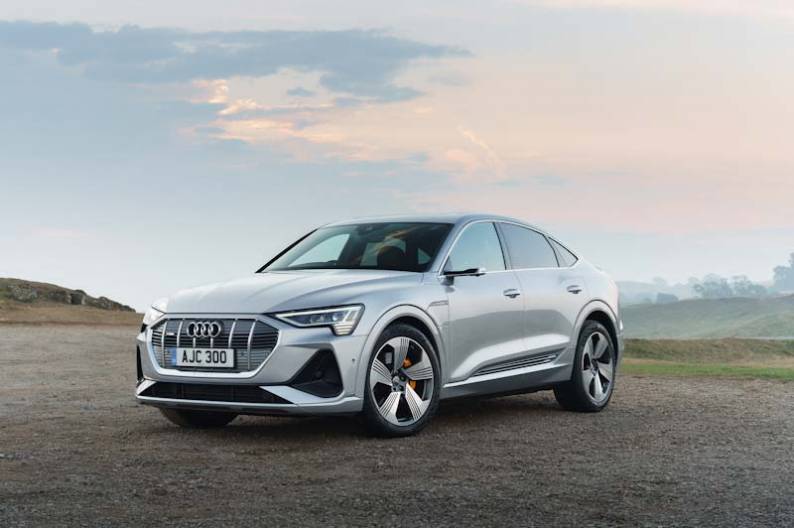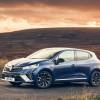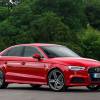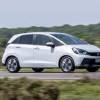
RAC sale – up to 33% off*
• Roadside cover from £5.29 a month†
• We get to most breakdowns in 60 mins or less
• Our patrols fix 4/5 breakdowns on the spot

By Jonathan Crouch
Introduction
Audi's e-tron EV brand got a sharper edge back in 2020 with this e-tron Sportback model. This Coupe-SUV offered a much more stylish look than the standard e-tron SUV bodyshape that had arrived just before it and, like that more conventional variant, offered the choice of two battery sizes and two or three-motor drive options. If you thought Jaguar's I-PACE was the only battery-powered luxury large SUV from the 2020-2022 era capable of rewarding at the wheel, a drive in one of these might make you think again.
Models
5dr SUV (50 quattro, 55 quattro, e-tron S)
History
What's possibly the least environmentally sensible vehicle genre on the market? That for sporting large coupe-styled luxury SUVs would have to be right up there, cars like the BMW X6, the Mercedes GLE Coupe and the Audi Q8. Could a car of this sort ever be really socially responsible? Could a car of this kind ever be really dynamic and rewarding to drive? With its e-tron Sportback model, Audi thought it could be.
This car, as its name suggested, was a fastback version of the brand's regular e-tron, the company's large full-electric EV which was launched in 2019 to battle segment rivals like Jaguar's I-PACE and the Mercedes EQC. The ordinary e-tron was an impressive feat of technology for its time, but could sometimes feel a little flat-footed in this company. The e-tron Sportback, announced in 2020, didn't just look more dynamic: Audi moved to make sure that it drove that way too. Especially in top e-tron Sportback S form.
Unlike the smaller Q4 or the larger e-tron GT, this e-tron Sportback didn't sit on a purpose-designed EV platform: which meant that, as with the ordinary e-tron SUV, the car's consequently portly weight delivered driving range figures that lagged behind those of the class leaders. There was plenty of technology to compensate though; the sci-fi-style 'Virtual Mirrors' for instance, 'L'-shaped pods that replaced ordinary door mirrors and transferred footage of what was happening behind to screens integrated into the doors where door handles would normally be. Then there was the clever front and rear axle decoupling system, so the drive could be limited to the rear motor in low-demand situations, maximising range. The e-tron S variant went further, launched in late 2020 as the world's first EV with a powertrain using three electric motors, one big one at the front and two more at the rear. A format which ushered in a whole new era of drive dynamics for high performance electric vehicles.
Both the e-tron SUV and the e-tron Sportback were replaced, respectively, by the Q8 e-tron and the Q8 Sportback e-tron models in early 2023.
What You Get
What we've got here is certainly a substantial piece of Ingolstadt real estate, over 4.9-metres long and sitting over 1.6-metres high, though there's plenty of panelwork sculpting to disguise the bulk, including the mid-level crease that flows through the door handles and a prominent upper swage line that emphasises the powerful rear haunches. The lower edge of the third side window rises towards the rear - a typical Audi Sportback feature. And between the upward-slanting lower crease and the lower side sills is a trim panel that's either black (with the standard e-tron Sportback) or silver (with the S model), either way supposed to draw the eye to where the battery, and thus the energy centre of the car, can be found. Nice touches if fitted include the optional virtual mirrors, 'L'-shaped pods that protrude on aerodynamic stalks replacing ordinary door mirrors; and the inclusion of charging flaps on both sides of the car behind the front wheel arches, which feature copper-themed e-tron badges and neatly open with the push of a button.
As usual with modern Audis, the front end is dominated by the kind of huge octagonal Singleframe grille you might think an EV wouldn't need. This one, which has lower e-tron branding, is light platinum grey with vertical struts and if you look closer, you'll see that it's mainly enclosed, signalling the car's battery status. At the rear, as is usual with Audi's latest large models, a light strip connects the LED tail lamps to one another, emphasising the substantial 1,935mm body width.
Which as you'd expect is the same up front as with the company's ordinary boxier e-tron large SUV. Which means that, like other more conventional large Audi models, you get two central MMI touch response displays that blend into vast swathes of piano black trim. You view another screen through the four-spoke wheel, this one a 12.3-inch 'Virtual Cockpit' monitor that includes a 'Power Meter' covering the car's charging and regenerative functions. The leather-stitched seats are superbly comfortable and position you fairly loftily - which is one of the reasons why forward vision is excellent. And there's plenty of interior storage, including a central open-sided compartment between the seats that's intended to have the feel of a light, sleek sculpture. It's unusual, much like the gear selector, which is operated by a hand rest which appears to 'float' above the console and is activated by a one-touch action conducted with either thumb or index finger.
In the back, this Sportback's 20mm reduction in ceiling height might bother you if you're a 6-footer - your head will be brushing the immaculately crafted roof liner - but otherwise, it feels pretty spacious in the rear. As for cargo space, well there's a compartment under the bonnet, but since that's only 60-litres in size, we'll ignore it and focus on the boot area. You get a powered tailgate of course, which rises to reveal a 555-litre luggage bay for this Sportback body shape - which is 45-litres less than the ordinary boxier e-tron SUV body shape can offer. There's also a useful under-floor storage area. Fold down the rear bench (which folds conveniently in a 40:20:40-split) and 1,595-litres of capacity is freed up. That's 60-litres less than an ordinary e-tron SUV body shape.
What You Pay
Please fill in the form here for an exact up-to-date information.
What to Look For
You're going to need to be aware of a number of issues if you commit to an Audi e-tron Sportback, these mainly centring around charging, software, battery and moisture build-up. We've also come across suspension and braking system problems. But these don't need necessarily to be an issue if the car you're looking at has had regular checks at an Audi franchise.
From the beginning, this model experienced battery problems and the brand had to recall over 1,600 vehicles shortly after launch in 2019. Some of these vehicles showed a malfunction in the battery location area - specifically a faulty grommet seal. Tests showed that the grommet allowed moisture to affect the battery, a problem that could lead to a short circuit - and ultimately even to a fire. There are also concerns in this period that the lithium ion batteries used might contain harmful chemicals and in extreme circumstances could produce fire. A yellow light on the dashboard blinks when there's something wrong with the battery and at this point, the driver should immediately stop the car and leave it in an open area.
We came across a number of software issues reported: a number of owners pointed out that the home charger function working with the GPS location often doesn't work. This means that if you want to enable the timer mode automatically, it often isn't possible, meaning that it's necessary to manually adjust the time button when home charging. We also came across owners who experienced navigational problems, pointing out that the car's GPS system easily forgot their home address, meaning the manual need to continually enter it all over again. All of these are software issues that can be solved by a dealer, but shouldn't have to be.
Check that the car you're looking at doesn't have difficulties when starting a charge session, usually because of connector issues. In some cars, the connector can't make a proper contact, which affects the connection between the car and the charger. You have to make sure the connector is pushed firmly into the charge port, a movement that will create the required connection, which will enable you to start the charging session.
We came across a number of e-tron Sportbacks that had moisture build-up problems. These tend to affect models built in the 2019 production year. These cars tend to build up moisture in the electrical system, which causes various issues and can lead to short-circuiting. If a warning appears in the centre display like 'electrical system fault', this could be a sign of this sort of problem.
We also came across suspension and braking system issues - specifically troubles with the anti-lock braking set-up and the electronic stability control. These issues caused Audi to recall quite a few models built in the 2020 to 2021 model years, so if you're looking at one of these, make sure the car you have in mind has had the recall.
Replacement Parts
(approx based on an e-tron Sportback 55 quattro 2020) - Ex Vat) A pollen filter costs in the £24-£50 bracket. Front brake pads sit in the £111 bracket for a set; for a rear set, it's around £72. Rear brake discs sit in the £130 bracket. A wiper blade is in the £5-£56 bracket.
On the Road
By 2020, electric cars had come on quite a lot. Two electric motors were by now de rigeur on larger luxury models like this one and, uniquely, faster versions of this Audi could now even offer three. We'll get to that, after we've briefed you on the core offering here for the twin-motor 'e-tron Sportback 50' and 'e-tron Sportback 55' models most customers for this model line will be looking at. Both share pretty much exactly the same engineering as the existing, boxier e-tron SUV launched back in 2019. Which means that, as with that body shape, there are two battery options, the base '50' variant using a 71kWh powerpack and the more popular '55' derivative that, like all other e-tron Sportbacks, features the bigger 95kWh battery.
Either way, with these two models, your battery of choice powers two electronically linked asynchronous motors, one on each axle. This in turn creates an electrified interpretation of Audi's quattro all drive system, though in low demand situations the car will be rear-driven thanks to a decoupling system that disconnects the front drive motor when it isn't needed. As you might expect, the electric motor output you get depends on the variant you choose. The entry-level '50 quattro' model offers 313PS and has a best possible 215 mile rated range; the '55 quattro' variant has 360PS (or up to 408PS if you select an 'S' overboost mode) and its bigger battery improves the range figure to a (still rather modest) best possible figure of 281 miles. That's in between 8.9 hour charge sessions using the 11kW wallbox charger that Audi recommends. If you're fortunate enough to find a 150kW public charging point, up to 95% of battery capacity can be replenished in just 50 minutes.
The other variant available in the range is the top e-tron S Sportback performance version, which was the world's first electric vehicle to use three drive motors. The larger electric motor that on a conventional e-tron Sportback sits at the rear was here moved to the front, freeing up space for twin smaller motors to sit on the back axle, allowing torque vectoring and fully variable torque distribution between the rear wheels for considerably enhanced - and really rather astonishing - levels of cornering agility. Extra motive power in this S model means a higher output of course - up to 435PS with 808Nm of torque; or, with the 'S' mode engaged for overtaking, 503PS, with a thumping 973Nm of torque. Enough to simply hurl this Audi at the horizon; 62mph from rest is recorded at 4.5s: driving more sedately, the S variant's WLTP-rated driving range figure is 236 miles.
Unlike its rivals from Jaguar and Mercedes, Audi fitted air suspension as standard to all e-tron Sportbacks and it imperiously deals with speed humps and potholes, plus it can lower itself to give the car greater stability at speed. You can also use this set-up to raise the car by up to 72mm, giving it a surprising degree of off road prowess. This Audi can also select its own level of brake regeneration - or you can dial that up or down yourself by using these steering wheel paddles. Talking of brakes, the ones here are excellent thanks to a clever electrohydraulic brake control system that combines brake regeneration and the wheel brakes in one single pedal movement. Like much else about this car, it's very clever.
Overall
Arguably, this Sportback e-tron variant was the car the standard SUV model ought to have been. A large luxury EV that was more than just a statement of technology. But one instead with extra pavement presence and an added dose of engagement. The compromises required over the ordinary e-tron SUV in terms of rear seat passenger space and luggage capacity shouldn't be too taxing for most likely owners to make. And this Sportback variant also showcased some useful changes to e-tron tech that Audi had made since this sub-brand's original launch.
Ultimately, as with the ordinary e-tron SUV, you'll have to really like the Audi brand to really want one of these. But if you appreciate Ingolstadt's cool, understated, considered approach to luxury motoring, then here a future that's very Vorsprung durch Elektrisch beckons.







![Audi A8 [D2] (1994 - 2003) used car review](https://d1ix0byejyn2u7.cloudfront.net/drive/images/made/drive/images/remote/https_d2yv47kjv2gmpz.cloudfront.net/filestore/7/1/3_14f980b905d539b/22e19ae9c4d1d78febae0bea5bcc043f/317_bab81818ce0ecde_100_100_70_c1_c_c.jpg)